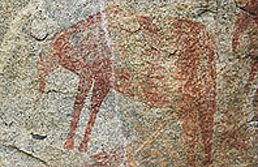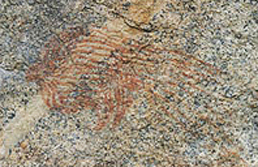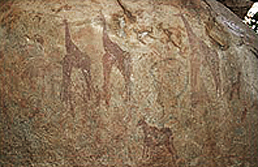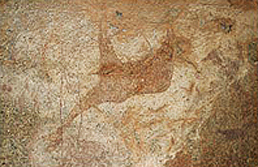 |
 |
Taru |
Site 25 |
Singida / Singida District / Ikungi Division
This is perhaps the most prolific and the best-preserved site in the whole of Ikungi division. It is in the same kind of vegetational pattern as the previous three, but on the slopes of Taru hill. The site is a straight faced rock shelter on the southern face of which are depicted several animals in very elaborate style employing two shades; deep red and light ocherous red.The subject matter includes animals such as elephants, giraffes, eland, ostrich, monkey, porcupine and so forth and anthropomorphs. The animals are drawn in three main naturalistic styles; the open line profile without shading, open line outline with shading, and bold silhouettes. The humans are mostly stylised, but they do not seem to suggest any kind of activity. Instances of overlap suggest, unlike in many other sites, that the scarlet red was painted over and therefore later than light ocherous red.
As mentioned earlier, the site is still in a good state of preservation, but since we do not know how long it will remain in this state, it is strongly recommended that it should be carefully documented for possible preservation and reproduction at the museum.
 |
 |
Ng’wa Mwango |
Site 26 |
Singida / Iramba District / Kisiriri Division
These three names, which are used interchangeably, refer to an exterior cave with openings aligned on the North West and South West orientation. It is located about 1.5km east of Isanzu mission and easily accessible via a path from the mission.
The site has two painted areas: the ceiling in the central part of the cave and a huge boulder on the southwest opening of the cave. In the former, most of the paintings, which are now badly faded, are done in white ashy latex paint. In the majority of cases, the subject matter seems to have been pacyderm-like animals, probably elephants. In the latter, the paintings, which are done in shades of ocherous red are still very clear, but there is no evidence of these having been superimposed on the faded white animal paintings.
Most of the red paintings do not appear on the ceiling, but are drawn on the boulder in the Southwest entrance of the cave. The friezes include many animals such as eland, zebra, and various antelopes, but the predominant species represented is the giraffe. All are portrayed in boldly shaded naturalistic silhouettes. There are also several human representations either in stylised or semi-naturalistic styles depicted in association with the animals in red pigment.
This is one of the sites whose pictographic representation can be identified as a hunting scene (Masao, 1979). This conclusion was arrived at because some of the drawings show animals, which have fallen down or are lying upside down, suggesting that they are dead. In addition, a giraffe is shown with three possible arrows sticking from its hindquarters, while behind it is a hunter with a bow and arrow. It is also thought that some of the human figures were in a festive mood rejoicing and dancing, perhaps after a successful hunt. In addition, alongside the fallen giraffe, one can see what looks like bolas or missiles in the form of three spherical objects tied to what looks like a piece of string. While this interpretation may be correct, it is as already cautioned, misleading to draw literal translations from the visual imagery of the paintings. Indeed in the light of recent work elsewhere, such interpretation would be considered very simplistic. Such depictions may have had completely different meaning in the lives, beliefs and cosmology of the artists.
Ng’wa Mwango is a site at which the varying shades of red suggest that the pictographs were painted at different times. For instance, it was observed that the scarlet red pigment invariably overlies the light ocherous red. This would suggest that at this site scarlet red was used after the light ocherous red, but we do not know how much time elapsed.
The same site was visited and excavated in 1974 by Masao and his crew (Masao 1979). The archaeological deposits have been dated to 3.600 BP, but hitherto, it has not been possible to associate the rock art with the stratified cultural material. The significance of an upper grinding stone stained with the red ochreous pigment found in association with datable archaeological deposits is difficult to assess because the pigment stains could have been associated with activities different from those of rock painting.
Two skeletons, one of an adult and the other of a child were also excavated in 1974. Studies of these showed that they belong to a Bantu stock not very different from the present occupants of the area. However, the grave seems to have been dug through LSA deposits and so it appears to be of Iron Age. Overall, the site is in a good state of preservation although it has also been disturbed by treasure hunters, who have dug a hole on the south western entrance.
→
Rock Art in Tanzania
→
Tanzania Rock Art - Forward by Dr. Meave Leakey
→
Overview of Tanzania Rock Art Sites
→
Tanzania Conservation & Management
→
Tanzania Rock Art Sites|
1-2 |
3-6 |
7-9 |
10-12 |
13-14 |
15-16 |
17-18 |
19-21 |
22-24 |
25-26 |
→
Africa Rock Art Archive
→
Bradshaw Foundation
Like us on Facebook & Follow us on Twitter to receive news & updates:












